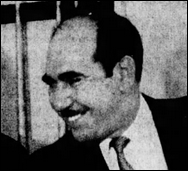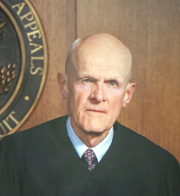Kampouris v. St. Louis Symphony ⸻ Story │ Record │ Discussion

Background Of The Case
In 1949, Louis Kampouris joined the St. Louis Symphony Society (Orchestra) as a performing artist employee (violinist), continuing in that position for the next 45 years. In December 1994, Kampouris was diagnosed with a medical condition (neurological/musculature issues in elbows/arms) requiring surgery, prompting him to take disability leave from the Orchestra (with insurance benefits).
In April 1997, following surgery and recuperation, Kampouris rejoined the Orchestra, with no (on-the-record) detectable degradation in his performing abilities. Nevertheless, in September 1997, the Orchestra terminated his employment. Kampouris objected to his termination.
District Proceedings

In March 1998, according to the District Docket (noting that many important docketed documents are unavailable in electronic form, some of them even remaining under seal, hence are/can not be included in this account), Kampouris filed a Federal Civil Complaint against the Orchestra, in the Eastern District of Missouri (St. Louis), alleging illegal Discrimination (age, disability), and also Intentional Infliction of Emotional Distress (under Missouri state law). The case was assigned to (Article III) District Judge Donald Stohr.
The Orchestra moved for Summary Judgment, based on (it claimed, regarding the counts of age and disability discrimination) skepticism whether Kampouris had adequately demonstrated fitness to return to work (believing, the Orchastra claimed, that deteriorated physical condition prevented Kampouris from playing to the Orchestra’s standards of artistry and stamina).
In June 1999, Judge Stohr granted the Orchestra’s Summary Judgment motion, ruling/concluding that the Orchestra had terminated Kampouris for legitimate non-discriminatory reasons, dismissed the case, and published his Order/Opinion (52 F.Supp. 2d 1096 (1999)) ⌥ ⌥.
Appellate Proceedings



In June 1999, Kampouris appealed to the Eighth Cir. Court of Appeals (St. Louis). The case was assigned to a panel consisting of Judges Morris Arnold, George Fagg, and Mark Bennett. In April 2000, the Appellate Panel issued its Decision (case №99-2704, 210 F.3d 845 (8th Cir. 2000)) ⌥ — per curiam, but consisting primarily of an extraordinarily important dissent by Judge Bennett (discussed infra) — affirming the District Court’s dismissal of the case.
In May 2000, petition for rehearing (both panel and en banc) was filed, but was withdrawn shortly thereafter because the case was settled by the parties.
Judicial Misconduct: Judge Bennett’s Big Dissent
The key to the Judicial Misconduct aspects of this (otherwise seemingly “vanilla”) case lies in Judge Bennett’s extraordinary dissent ?: “… I find that there are genuine issues of material fact in the record [DGIMF’s]” — thereby rendering the court’s grant of summary judgment dismissal improper/wrong/false/invalid. And hence, since the appellate opinion was written/issued knowingly/willfully falsely (since the other two judges were aware of Bennett’s points ahead of time), the Kampouris v. St. Louis Symphony decision amounts to Judicial Misconduct.
Specifically, Bennett’s dissent finds DGIMF’s in (at least) the following two places:
- Nature of perceived (or “regarded-as”) substantially-limiting disability/impairment, resulting in adverse employment action (which would implicate disability discrimination, prohibited under the ADA (Americans with Disabilities Act, later amended)) — The material-fact-claims on record revealed a clear genuine-issue dispute (DGIMF), which should/must be resolved by a jury (“determining credibility and declaring a ‘winner’”), but which was instead improperly/falsely resolved by the judges (“arbitrarily/capriciously ‘picking sides’”). Namely, sworn depositions by the orchestra revealed conflicting testimonies, supporting all three of the following (not-necessarily entirely consistent) inferences for why the orchestra took its adverse employment action (firing Kampouris): (i) the orchestra (in the person of Jeffrey Neville, Director of Orchestra Personnel) itself directly believed Kampouris was totally disabled (within the meaning of the ADA, from any/all occupations, not just his job as violinist); (ii) the orchestra believed that the insurance company designated Kampouris as totally disabled; (iii) the orchestra indirectly believed Kampouris was totally disabled only because the insurance company thought so. This fact-set gives rise to an important/significant question for the case, of which version (i–iii) (if any) accurately represents (as opposed to ex post facto pretextual falsification of) the orchestra’s actual contemporaneous/at-the-time-of-events perception of Kampouris’s impairments. That’s the kind of DGIMF question that can only be resolved by the ultimate fact-finder (the jury) at trial-time, not by a disinterested third-party law-interpreters (judges) at summary-judgment-time. Yet, the judges wrongly made their own choice on this question — namely, they decided that none of the versions (i–iii) was truthful (even though the orchestra admitted to them at various times, then “changed their mind”), as addressed in the next bullet item.
- Pretext (that is, the orchestra lying, by proffering a false reason, other than the real reason, such as (i–iii supra) for its adverse job action) — Instead, the judges improperly chose to believe the orchestra’s yet different “explanation" (other than the above admissions (i–iii)), namely that the orchestra terminated Kampouris for its laterally claimed reason that his performance was not up to the required artistic/musical standards demanded by the orchestra. Yet, “Mr. Kampouris has presented enough evidence to defeat summary judgment on the issue of pretext [, for] [t]he record undoubtedly generates a genuine issue of material fact [DGIMF] as to Mr. Kampouris’s ability to play to the required standards.” In such a situation, the question of the existence (or not) of pretext hangs in the air — it is a DGIMF. Which, again, can only be determined by the jury (not by the judge).
Therefore, since (at least) two DGIMF’s clearly/provably exist at summary-judgment-time, the case cannot (by the rule, mere existence of a DGIMF) be dismissed. But it was. That amounts to Judicial Misconduct. Period. Quoting from Bennett’s dissent (emphasis added):
The federal courts’ daily ritual of trial court [blind/unthinking] grants and appellate court [blind/unthinking] affirmances of summary judgment in employment discrimination cases across the land is increasingly troubling to me. I worry that the expanding use of summary judgment, particularly in federal employment discrimination litigation, raises the ominous specter of serious erosion of the “fundamental and sacred” right of trial by jury.
Afterword
Judge Bennett has more than once thumped his theme of judicial-misconduct-via-abuse-of-summary-judgment (generally, not necessarily in the context of cases he sat in judgment upon). His most fully-formed writing on the subject occurs in his essay at the NYLSLR Symposium, with the unwieldy title From the “No Spittin’, No Cussin’ and No Summary Judgment” Days of Employment Discrimination Litigation to the “Defendant’s Summary Judgment Affirmed Without Comment” Days: One Judge’s Four-Decade Perspective (wherein he cites his own opinion/dissent in the herein-reviewed Kampouris v. St. Louis Symphony). Suffice it here to quote from that essay (emphasis added):
Nearly seventy-five years after its birth, the time has come to bury summary judgment. The funeral should be swift, dignified, and joyous. The autopsy would reveal that the cause of death was abuse and overuse by my federal judge colleagues. Summary judgment abuse and overuse occurs in all types of cases, but is especially magnified in employment discrimination cases. This problem is exacerbated by the [blind/unthinking] daily ritual of appellate courts affirming summary judgment grants to employers, often without comment, at a rate that far exceeds any other substantive area of federal law. These beliefs are based on my four-decade career in employment discrimination as a trial and appellate lawyer (for both employees and employers), adjunct law professor, author, speaker, federal magistrate judge, and district court judge. Unfortunately, my colleagues have become increasingly unfriendly to plaintiff’s employment discrimination claims.
[I]n 2000, while sitting by designation on the Eighth Circuit Court of Appeals, I jumped into the summary judgment fray when I wrote a dissent from an all-too-routine per curiam affirmance of summary judgment in an employment discrimination case [Kampouris v. St. Louis Symphony]:
The federal courts’ [blind/unthinking] daily ritual of trial court grants and appellate court affirmances of summary judgment in employment discrimination cases across the land is increasingly troubling to me. I worry that the expanding use of summary judgment, particularly in federal employment discrimination litigation, raises the ominous specter of serious erosion of the “fundamental and sacred” right of trial by jury.
Five years later, I observed,
I think that the trend away from jury trials toward a new focus on expensive discovery and summary judgment has been fueled by the [false] complicity of federal trial and appellate judges.
… [M]y voice is not alone [citing/quoting several concurring/sympathetic judges]. … My thirty-five-plus years of experience with employment discrimination litigation and summary judgment cause me to strongly favor [that]: summary judgment is a huge part of the problem with our civil justice system, and its expanded and aggressive use is not part of the solution.
Etc., etc., etc. It would be redundant/unnecessary/wearisome to repeat more of these same types of arguments here, ad nasueum/infinitum. Read (really, study/research) this site (and all its more-authoritative cited sources) in toto. Shortcuts won’t suffice.
